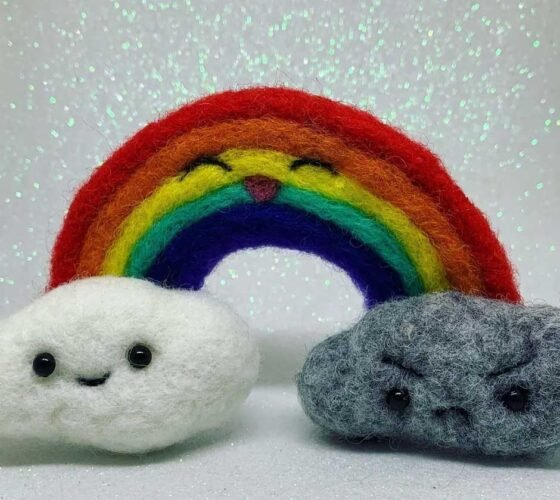Needle felting has taken the crafting world by storm, combining creativity, texture, and tactile satisfaction in one artistic medium. Whether you’re sculpting adorable animals, whimsical landscapes, or abstract art, one technique that can dramatically elevate your work is needle felting color blending. This blog will unlock the rainbow for you, guiding you through advanced and imaginative methods to blend colors with stunning results.
Why Color Blending Matters in Needle Felting
Color blending brings depth, dimension, and realism to needle felting projects. Imagine crafting a sunset landscape without the gradual transition of fiery oranges to dusky purples—the piece would lack emotional impact and visual flow. Blended colors mimic nature’s gradients, provide shading for 3D effects, and allow for personal artistic expression that pure colors alone can’t achieve.
Understanding the Basics of Color Theory
Before diving into insane techniques, it’s crucial to have a basic understanding of color theory:
- Primary Colors: Red, yellow, blue
- Secondary Colors: Green, orange, purple (created by mixing primary colors)
- Tertiary Colors: Blends of primary and secondary hues
Also, learn about warm vs. cool colors, complementary pairs, and analogous schemes to guide your color choices and avoid muddy results.
Materials You Need for Blending Colors
To master needle felting color blending, gather these materials:
- A variety of wool roving or batting in different shades
- A felting needle (preferably size 36 or 38 for blending)
- A blending board or hand carders
- Foam felting pad or brush mat
- Tweezers (for precision work)
Optional but helpful:
- A color wheel
- Photo references or color swatches
Technique 1: Hand Blending
Best for: Beginners and small areas
Hand blending involves pulling apart wool and layering fibers by hand:
- Take equal or varied amounts of two or more colors.
- Tease the wool by gently pulling it apart.
- Lay the teased pieces in alternating layers.
- Pull and re-stack multiple times until the fibers are thoroughly mixed.
This method gives you control over the intensity of each color and is great for quick, localized blends.
Technique 2: Carding for Gradient Blends
Best for: Large projects and smooth transitions
Using hand carders or a blending board, you can create seamless gradients:
- Load small amounts of different colors in stripes or patches on the carder.
- Use a second carder to brush and mix the fibers together.
- Roll off the wool into rolags or batts.
- Pull thin strips to needle felt with, adjusting the concentration of colors as needed.
This technique is ideal for ombré effects, like the transition from blue sky to golden horizon.
Technique 3: Layered Needle Blending
Best for: 3D shading and realistic textures
Instead of pre-mixing wool, you can blend colors directly on your felting project:
- Lay down a base color.
- Add a thin layer of a second color on top.
- Gently needle the second color in, allowing some of the base to show through.
- Alternate between the two until you achieve a soft gradient.
Use this to mimic fur patterns, feather shading, or soft highlights on cheeks.
Technique 4: Stippling and Speckling
Best for: Textures and visual interest
To create a painterly, pointillist effect:
- Pull tiny tufts of accent colors.
- Lightly needle them in spaced, random patterns.
- Build up color density gradually.
This technique works beautifully for animal markings, forest floors, or abstract designs.
Technique 5: Controlled Chaos
Best for: Organic effects and color explosion
Sometimes, you want your colors to clash or bleed naturally. Here’s how:
- Take bold, contrasting colors.
- Lightly layer them in a chaotic swirl.
- Needle lightly at first to preserve texture.
- Add directional felting to stretch the blend.
This is great for fiery mane effects, magical elements, or psychedelic art.
Tips for Successful Needle Felting Color Blending
- Always test your blendbefore applying it to the main piece.
- Less is more: Start with less accent color; you can always add more.
- Watch your needle direction: Angled stabbing can shift fibers and affect the gradient.
- Use reference imagesfor realistic shading.
- Practice light pressureto maintain fluffiness during blending.
Advanced Bonus: 3D Color Sculpting
Want to take your color blending into the third dimension? Use color to sculpt:
- Create shadows with darker fibers on one side.
- Highlight ridges and high points with lighter colors.
- Add visual depth by layering cool hues beneath warm ones.
This approach is used in hyper-realistic animal sculptures or fantasy creatures.
Troubleshooting Common Mistakes
- Muddy Colors: You may be over-blending or combining complementary hues too aggressively.
- Flat Look: Add more contrast or layer with stippling.
- Harsh Lines: Soften by blending with hand carders or lightly layering more fiber.
Inspiring Project Ideas
- Rainbow Galaxy Ball: Blend purples, blues, and pinks for a galactic felted sphere.
- Sunset Landscape Panel: Card warm hues for a smooth horizon gradient.
- Fantasy Creature: Use chaotic blending to design a unique, color-rich animal.
- Ocean Coral Scene: Speckle teals and oranges for vibrant sea life.
Your Color-Blending Journey Starts Now
Needle felting color blending isn’t just a technique—it’s an art form. From subtle gradients to wild, uncontained explosions of color, your blending skills can turn simple wool into masterpieces that pop with emotion and detail. With patience, practice, and a fearless approach to experimentation, you too can unlock the full spectrum of your creativity.
So, grab your wool and felting needle, and start blending your way to stunning results. The rainbow is yours to command!






